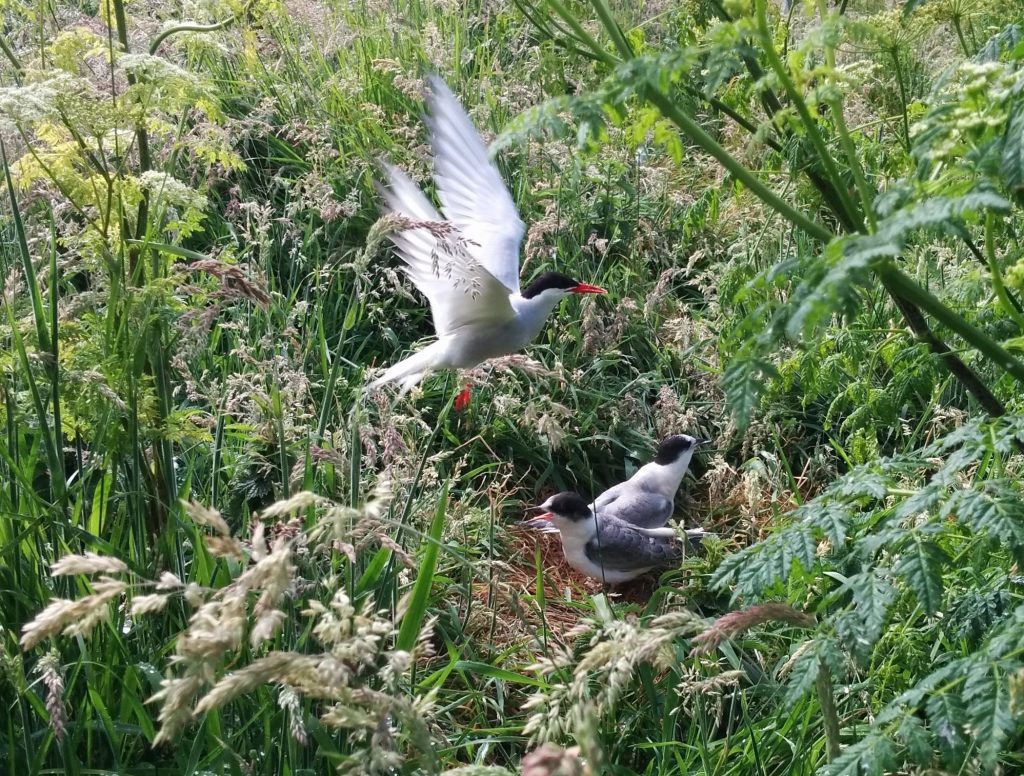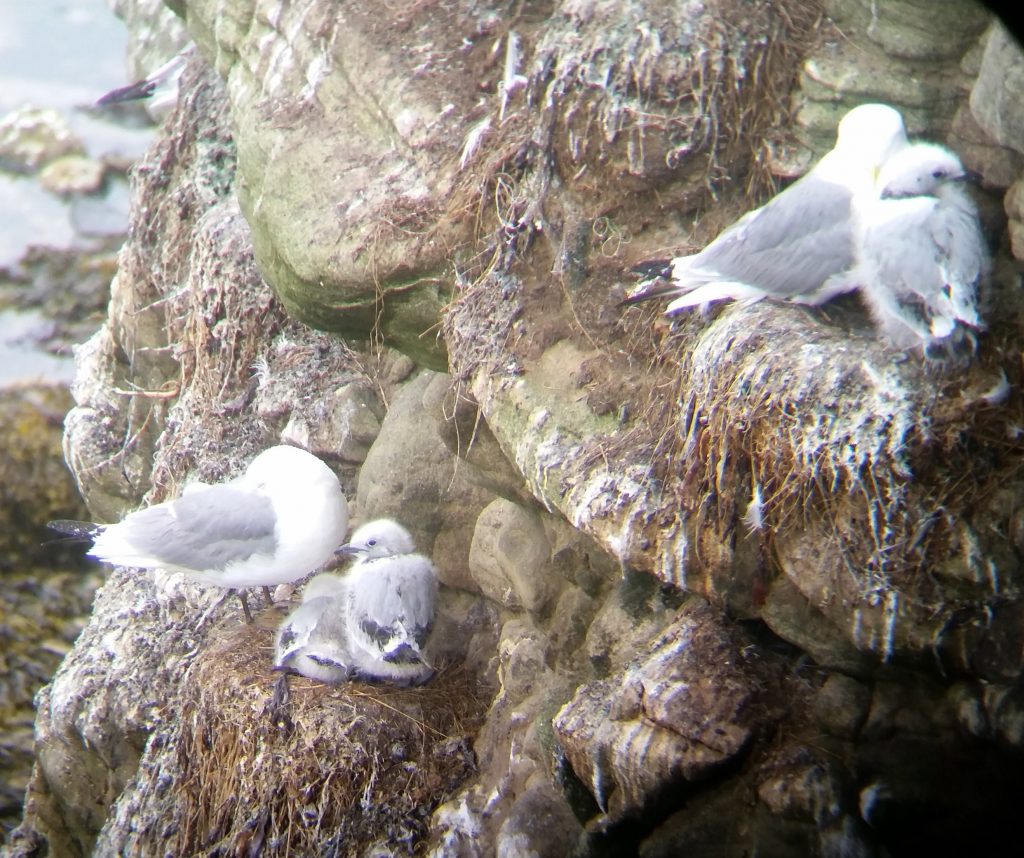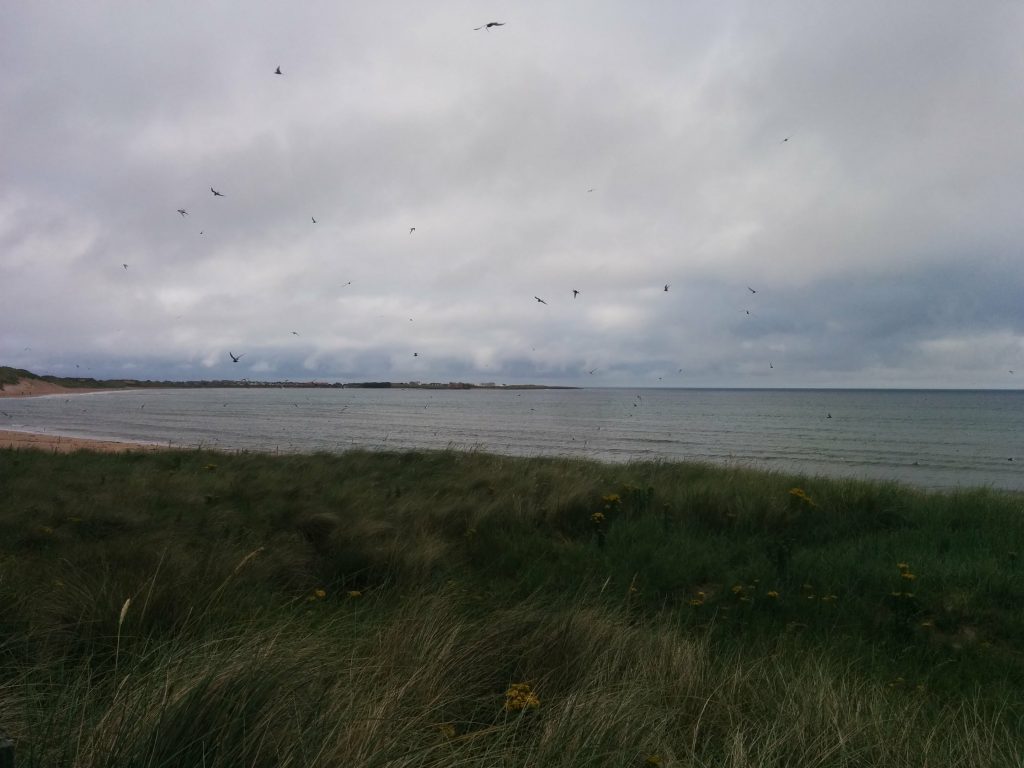One favorable consequence of always carrying binoculars in plain view is that they help create an international citizenry of nature lovers.
I’ve just returned from a trip to England visiting family. There, we camped in the chilly, Scotland-like region of northeast England called Northumberland – in Latin, the “North Shadows” – an island-pocked coastline of temperamental weather and steep cliffs wedged between rocky and sandy beaches.
We planned to visit the Farne Islands, an internationally recognized bird nesting area most famously home to almost 40,000 breeding pairs of puffins. I quickly found that tucked more secretly away, though, the mainland coast held just as much to fascinate me.
Walking the coastal path one morning, we paused to ask directions of an older couple. They told us where to go, then happened to follow on the same path. A few minutes later they called out from behind us. “Don’t miss the kittiwakes!”
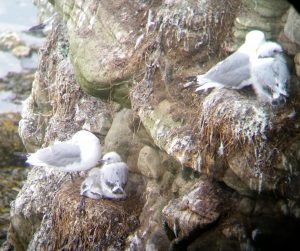 Where we had just passed, on a cliff that fell away from our feet to the sea, hundreds of nesting kittiwakes clung to the stone. Their tiny babies crouched beside them, white puffs the color of the guano streaking the cliff like ice. It seemed a miracle the chicks didn’t fall from nests hardly bigger than an outstretched hand.
Where we had just passed, on a cliff that fell away from our feet to the sea, hundreds of nesting kittiwakes clung to the stone. Their tiny babies crouched beside them, white puffs the color of the guano streaking the cliff like ice. It seemed a miracle the chicks didn’t fall from nests hardly bigger than an outstretched hand.
Two days later we walked a stretch of sandy beach in the town of Beadnell, and again paused to ask directions. Mirroring the words of the couple the day before and no doubt noticing my binoculars, the woman added, “Don’t miss the breeding tern colony. You’ll have to go around the mouth of the river at the end of the beach, but once you do, it’s right there.”
We hurried our steps. The day had grown late, although so far north, light lingers long into the evening. I feared the rangers at the site would go home before we could talk to them. It turned out I needn’t have worried.
As we approached, we could see terns folding their wings to plunge like white needles into the ocean. The dunes rose to our right, marron grass bent like punished backs in stiff winds. We crossed a footbridge over the river and approached the Long Nanny Tern Colony, run by the British National Trust.
A small ranger station stood among low dunes. To our left four or five green tents mounded up, tucked away from the wind. Out to sea stretched a sandy spit marked by colorful nest boxes.
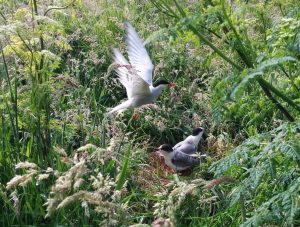 And all around us, almost close enough to touch, flitted terns and terns and terns, their half-grown chicks round lumps among the dunes where they nest on the ground. The urgent cries of adult Arctic terns filled the air as, fish in tow, they hovered to feed their chicks.
And all around us, almost close enough to touch, flitted terns and terns and terns, their half-grown chicks round lumps among the dunes where they nest on the ground. The urgent cries of adult Arctic terns filled the air as, fish in tow, they hovered to feed their chicks.
A young ranger with black hair and a beard met us on the station’s wooden deck. An environmental scientist from Spain, no older than 25, he had a gentle manner and a quiet, warm voice. He helped us view the birds through the station’s long spotting scope.
He told us that he and his fellow rangers spend 24 hours a day at the station. They protect the terns, driving off predators, keeping humans from treading on the nests, and guarding nests from incoming tides. They work in eight-hour shifts so that someone is always awake with the birds.
Two types of tern nest there, he said. The site boasts 1,800 breeding pairs of Arctic terns, but only 28 pairs of the rare Little tern, for which the Long Nanny site was created.
“We had 38 pairs this year,” he said, “but then we had a freak high tide. We were only able to save 28 of them.”
Little terns, he explained, nest directly on the beach, right next to the sea. When eggs are first laid, the rangers move each nest meticulously onto a nest box, recording and mimicking each nest’s precise arrangement and location. During dangerous tides, the rangers race to the shore to move the nest boxes away, returning them to their correct spot when the tides recede so the adults can find the nest again.
Last year, only two of the site’s fledglings survived due to the presence of stoats that wreaked havoc on Arctic and Little terns alike. Now the rangers have a nocturnal scope that sees heat, which helps in spotting predators. Still, the main thing for breeding success this year, the ranger said, was that the stoats did not return.
As we stood chatting, a cloud of terns suddenly rose fifty yards away, crying an alarm call. “That means there’s something there,” he said. “I’m sorry, I have to go.”
And hastily he ran off over a path across the dunes, to stand among the terns and clap loudly to drive off any intruder.
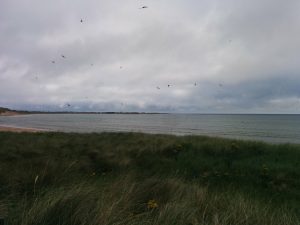 Later, I wondered at the efforts of this young man and of his fellow rangers. There’s a heroism in such work, mingled with a kind of tragic fatalism. These birds are just one example of all the threatened creatures in the world. And the struggle to survive is so fierce that just two chicks in a year might live out of thousands, even when protected.
Later, I wondered at the efforts of this young man and of his fellow rangers. There’s a heroism in such work, mingled with a kind of tragic fatalism. These birds are just one example of all the threatened creatures in the world. And the struggle to survive is so fierce that just two chicks in a year might live out of thousands, even when protected.
I’ve frequently pondered how best to be helpful in the uphill battle known as environmentalism, where failures seem more common than success. This young man at Long Nanny was stewarding just one small area, one type of bird. But his contribution, I think, is as great as any other.
There’s something noble in the saving of even a single life. In a sense, all environmentalism boils down to that one thing: allowing yet one more life to live in peace and plenty for a little while longer.
In a speech at Smith, the poet W.S. Merwin once said he believes we must focus on saving one tree at a time, to be appreciated in our own lifetime. Asked how he holds on to hope for the future of the environment, he said, “I don’t.” But we’re only alive now, he said, and must turn our efforts to keeping the beauty of nature alive right now, for ourselves and those around us, to the extent and for as long as we can.
The reward is right now – this bird, this beach, this tree, this landscape – not necessarily a general victory.
Eventually, we did visit the Farne Islands, where no predators roam and visitors are tightly controlled. The birds there were unforgettable, too. Guillemots, shags, razorbills, kittiwakes nested in their thousands on cliffs that rose twenty feet over our heads as our boat floated on the sea. Puffins darted past with beaks strung with fish, and padded on big orange feet beside their burrows in the soil on the main island.
But my favorite place remained the wind-swept dunes and lonely spit of Long Nanny.
I love the way writing about it this morning returns me to the spaces of Northumberland: clean salt air, beaches the color of ancient paper, terns a thousand white shreds against a cloudy sky. The hard work of a few young people stubbornly gluing themselves to the beach helped create this for me and all of us. Because of them, the terns are there.
What else is there but that?
Naila Moreira is a writer and poet who often focuses on science, nature and the environment. She teaches science writing at Smith College and is the writer in residence at Forbes Library. She’s on Twitter @nailamoreira.

